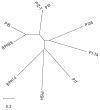Map-based cloning and characterization of a brown planthopper resistance gene BPH26 from Oryza sativa L. ssp. indica cultivar ADR52
- PMID: 25076167
- PMCID: PMC5376202
- DOI: 10.1038/srep05872
Map-based cloning and characterization of a brown planthopper resistance gene BPH26 from Oryza sativa L. ssp. indica cultivar ADR52
Abstract
The brown planthopper (BPH) is the most serious insect pest of rice in Asia. The indica rice cultivar ADR52 carries two BPH resistance genes, BPH26 (brown planthopper resistance 26) and BPH25. Map-based cloning of BPH26 revealed that BPH26 encodes a coiled-coil-nucleotide-binding-site-leucine-rich repeat (CC-NBS-LRR) protein. BPH26 mediated sucking inhibition in the phloem sieve element. BPH26 was identical to BPH2 on the basis of DNA sequence analysis and feeding ability of the BPH2-virulent biotype of BPH. BPH2 was widely incorporated in elite rice cultivars and was well-cultivated in many Asian countries as a favorable gene resource in rice breeding against BPH. However, BPH2 was rendered ineffective by a virulent biotype of BPH in rice fields in Asia. In this study, we suggest that BPH2 can be reused by combining with other BPH resistance genes, such as BPH25, to ensure durable resistance to BPH.
Conflict of interest statement
The authors declare no competing financial interests.
Figures






References
-
- Schoonhoven L. M., van Loon J. J. A. & Dicke M. Insect-Plant Biology, 2nd Ed. (Oxford University Press, New York, 2005).
-
- Clement S. L. & Quisenberry S. S. Global Plant Genetic Resources for Insect-Resistant Crop. (CRC Press LLC, New York, 1999).
-
- Nasu S. Rice leafhoppers. In: The Major Insect Pests of the Rice Plant. 493–523 (Johns Hopkins Press, Baltimore, Maryland, 1964).
-
- Kisimoto R. Studies on polymorphism and its role playing in the population growth of the brown planthopper. Bull. Shikoku Agric. Exp. Stn. 13, 1–106 (1965).
-
- Dyck V. A. & Thomas B. The Brown planthopper problem. In: Brown Planthopper: Threat to Rice Production in Asia. 3–17 (International Rice Research institute, Manila, Philippines, 1979).
Publication types
MeSH terms
Substances
LinkOut - more resources
Full Text Sources
Other Literature Sources
Research Materials
Miscellaneous

